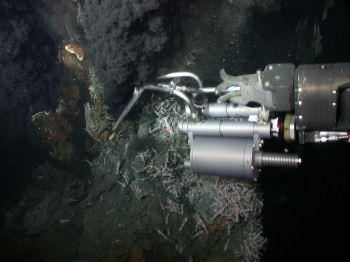Chemistry
By studying the chemistry of deep-sea vents in the Cayman Trough, we hope to get a clearer picture of hidden reactions between seawater and rocks deep in the Earth's crust, which ultimately control the chemical composition of seawater. And our project also examines the effects that mineral-rich fluids gushing from deep-sea vents have on the wider ocean - all part of figuring out how our planet works.
Deep-sea vents are the end product of the circulation of seawater deep into the Earth's crust, where it reacts with the surrounding rocks under heat and pressure. As the volcanoes of the mid-ocean ridge create new seafloor, seawater percolates down through cracks in that new crust. Eventually, at around 2 km deep, it can go no further, because the rocks of the Earth's crust become impermeable. But under the heat and pressure so deep in the crust, the seawater reacts with the surrounding rocks. Those reactions transform the water into a hot, mineral-rich fluid that rises back through the crust to erupt as deep-sea vents on the ocean floor.
Seawater is a cocktail of dissolved elements and minerals. Many of these ingredients are the by-products of the water cycle: rain falls on land, flows into rivers and out to sea, washing minerals from the continents. But when water in the oceans evaporates to eventually fall again as rain on land, the minerals are left behind in the oceans. So with every turn of the water cycle, more and more minerals are washed from the continents.
But the sea does not appear to get more salty over time. This is because other processes are also removing those minerals from seawater. Some minerals are removed by marine life, as various sea creatures make their carbonate or silicate shells. But for a long time, geochemists had a hard time 'balancing the budget' of the dissolved elements in seawater. Clearly something else was removing them, but no-one knew what.

The discovery of deep-sea vents in the late 1970s provided the answer. In the chemical reactions deep beneath the vents, seawater loses some of its dissolved elements to the surrounding rocks, most notably magnesium. So deep-sea vents are like the pool cleaners of the world's oceans - and the entire volume of the oceans passes through their circulation system every few million years.
Page 1: Pool cleaners of the world's oceans
Page 2: Deepest and hottest?
Page 3: Getting the big picture
Want to dive deeper?
Visit Venture Ocean to find out more about deep-sea vents
Explore the different types of deep-sea vents found so far on the ocean floor
Read more about the 'Lost City' vent field
Science
Find out more about the Cayman Trough, undersea volcanoes, deep-sea vents,
and the inhabitants of the abyss.
What are we investigating?


